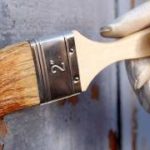What paint to use on wood – tips from professionals while you paint indoor and outdoor walls, ceilings or floors in your country house with your own hands
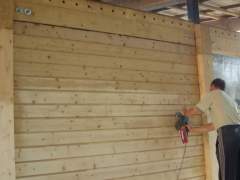 Wood is durable material, it keeps warmth very well, giving the house a unique atmosphere of comfort. With proper treatment of a wood house facade will give joy not only to the present owner of the house, but to his grandchildren and great-grandchildren as well. That’s why it’s very important to know what paint to use on wood and make a proper choice. In the past, many wooden houses were painted with oil paint. The result had been always the same – shabby blackened facades. So, the question “what type of paint to use on wood” is #1 for the responsible master. The moisture of the external environment can easily penetrate into the wood, and then mold, mildew and insects appear. The house itself gets ugly grayish hue as a result, and it’s subsequently destroyed, in fact.
Wood is durable material, it keeps warmth very well, giving the house a unique atmosphere of comfort. With proper treatment of a wood house facade will give joy not only to the present owner of the house, but to his grandchildren and great-grandchildren as well. That’s why it’s very important to know what paint to use on wood and make a proper choice. In the past, many wooden houses were painted with oil paint. The result had been always the same – shabby blackened facades. So, the question “what type of paint to use on wood” is #1 for the responsible master. The moisture of the external environment can easily penetrate into the wood, and then mold, mildew and insects appear. The house itself gets ugly grayish hue as a result, and it’s subsequently destroyed, in fact.
What paint is best for wood?
Nowadays, in the market of finishing materials for wooden facades there are many special wood protecting paints. They protect the wood from mold, blue stains, mildew, UV rays and weathering. These products have been tested by time for about 30 years already in the USA, and independent experts and professional builders confirm their protecting qualities.
The basic rules for the finishing of wood facades
#1 rule: Prepare the surface properly.
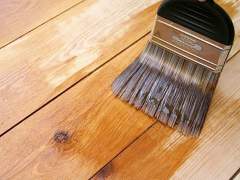 Advanced preparation of the wooden surface is an important and necessary step to obtain high-quality finishing of the wooden walls of the house. To begin, remove the dust. It is best to do it by rinsing the surface with water using a garden sprayer or a brush. If there are small cracks or surface defects, you can use putty. Quite often we can meet an advice that putty can handled only to dry wood. But if the timber you deal with is brand new, it’s usually still wet. So, there is no need to wait for the complete natural drying of the timber: during this time the wood will be cracking and darkening, it will have mold and fungus. It is suitable for wood moisture up to 40% to be treated. The special consistency and ingredients reduce of the solution improve its adhesion to the surface and prolong the life of the coating.
Advanced preparation of the wooden surface is an important and necessary step to obtain high-quality finishing of the wooden walls of the house. To begin, remove the dust. It is best to do it by rinsing the surface with water using a garden sprayer or a brush. If there are small cracks or surface defects, you can use putty. Quite often we can meet an advice that putty can handled only to dry wood. But if the timber you deal with is brand new, it’s usually still wet. So, there is no need to wait for the complete natural drying of the timber: during this time the wood will be cracking and darkening, it will have mold and fungus. It is suitable for wood moisture up to 40% to be treated. The special consistency and ingredients reduce of the solution improve its adhesion to the surface and prolong the life of the coating.
#2 rule: Choose the coating in a correct way.
Modern facilities are most commonly divided into alkyd and acrylic coverings. Alkyd compositions are solvent-based and they are much more resistant to weathering, so they are highly recommended for exterior decoration of the house. Acrylic (water-based) paints are optimal indoors. These covering compositions completely paint over the substrate. However, some vendors offer for wood finishing some brand new protective and decorative textural compositions that retain the visible texture of the timber, decorating and protecting it at the same time
The must-do operations if you have some problems with mold and blue stains
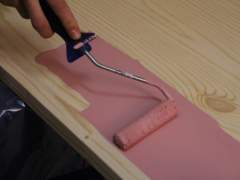 Better use water-dispersion paints for wood. Paints of this king do not contain an antiseptic, which usually leads to further destruction of the wood.
Better use water-dispersion paints for wood. Paints of this king do not contain an antiseptic, which usually leads to further destruction of the wood.- Use the bleaching composition and texture coating. It should be noted, that it’s very cheap, but labor-intensive process.
- For the timber of very dark shades you may use the surface texture composition.
The result of these operations will be the following: without additional efforts (whitening and priming) you re-fresh the color of the wood. It is not only painted, but also protected. You can choose the color of any desired hue. For the facade of a wooden house, you must use high-quality, time-tested and certified formulations only. It’s also very important to read the instructions on the packages of the paint in a very attentive way. Every modern coating has its own peculiarities.
Tips for good coverage
- Mix the composition prior to and during the application thoroughly, otherwise, the color will not uniform
- Apply the composition to dry, clean, dust-free surface only
- Test the color of the composition on a small, not-very-important area prior to painting process
- Note that shades of color intensity depend on the type of wood, quality and quantity of the deposited layers
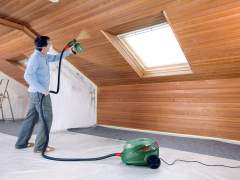 Surfaces with old paint must be treated with sandpaper in a very thorough way
Surfaces with old paint must be treated with sandpaper in a very thorough way- Apply coatings in 2-3 layers
- Paint wood outdoors when the weather is warm and not wet, but there is no need to paint the wood during the hot sunny days only as well. Rain and very wet weather will disturb the process and may even cause damage to the future coating
- Treat the ends of planks and logs with several layers of primer and topcoat. Use solutions specifically designed for this purpose for further protection of the ends of the logs. It prevents cracking and protects logs from rotting ends.
We hope this article helped you to get all the necessary information on what type of paints should be used for painting wood.


